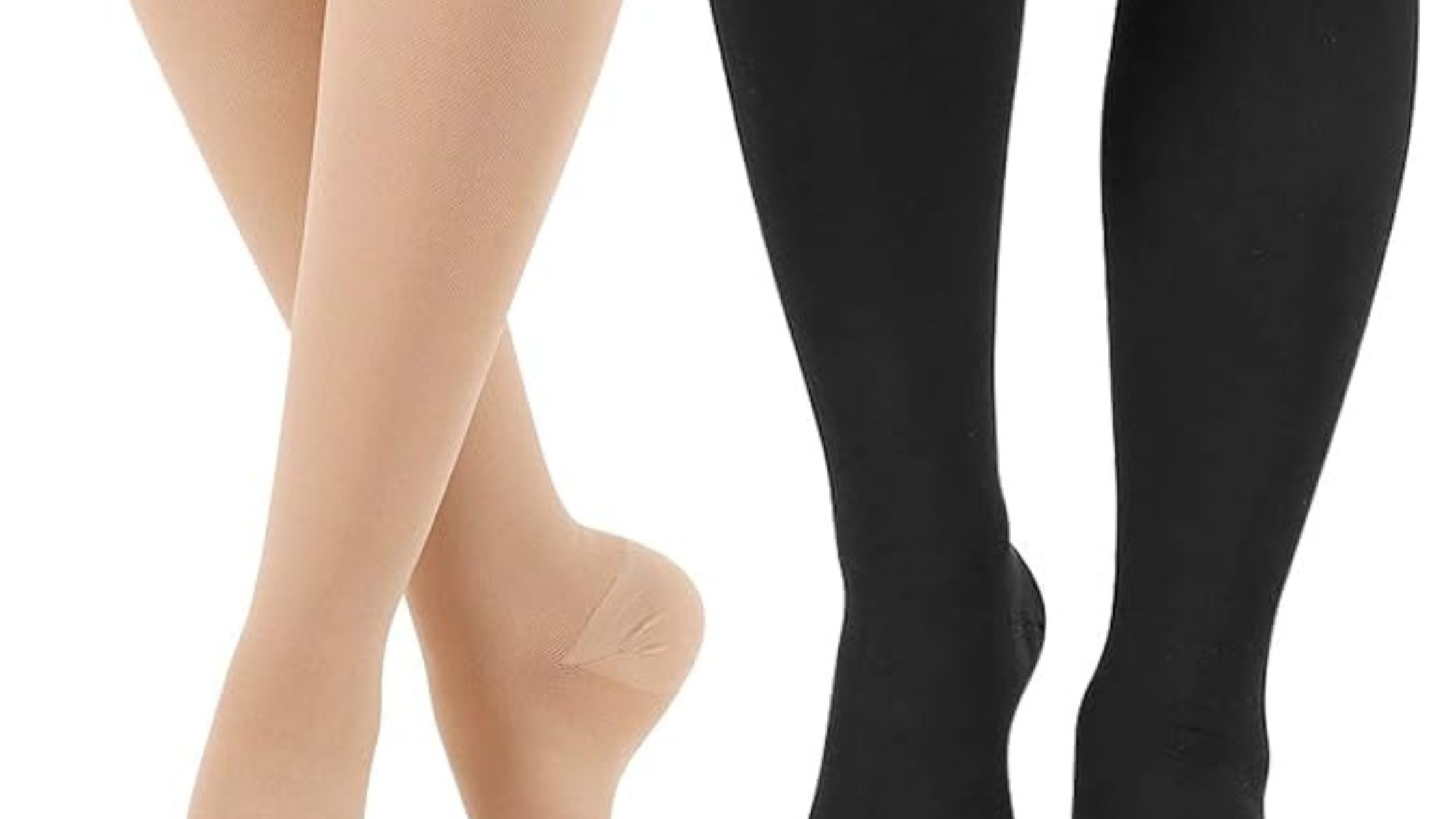Compression stockings are a widely used medical and lifestyle designed to increase circulation, reduce swelling and avert blood clots. Among the different types available, compression stockings provide high benefits for people requiring extensive leg cover without restrictions on full pantyhose.
Thigh high compression stockings can be a great answer whether you are recovering from surgery, dealing with CVI or looking for relief from weary and achy legs. This article discusses their advantages, medicinal applications, advice on selecting the appropriate pair and comfortable wearing suggestions.
What Are Thigh High Compression Stockings?
Specialized hosiery called thigh high compression stockings runs from the foot up to the thigh, offering graduated compression. Unlike knee-high stockings, which stop below the knee, or pantyhose, which cover the waist, thigh highs emphasize the lower leg and thigh region.
Designed with the greatest ankle compression, they gradually reduce the pressure as they rise. This design promotes blood flow back to the heart and thus reduces discomfort and swelling.
Key Features:
- Tightest at the ankle, lighter toward the thigh (Graduated compression)
- Made from (nylon, spandex, latex-free options) breathable, stretchable materials
- Available in different compression levels
- Different Open-toe or closed-toe designs
- Silicone bands or adhesive strips to prevent slipping
Benefits of Thigh High Compression Stockings
Improved Blood Circulation
By helping to stop blood pooling in the legs, compression stockings reduce the risk of DVT) and CVI. Progressive pressure helps veins to push blood up and therefore increases the overall circulation.
Reduced Swelling and Edema
Prolong standing or sitting can cause swelling of the legs for many individuals. The thigh high stockings reduce the accumulation of fluids and therefore relieve pain.
Prevention of Varicose and Spider Veins
Compression stockings can help prevent or reduce the occurrence of spider and varicose veins by maintaining a vein function, which is the result of weakened vein wall force.
Enhanced Athletic Performance and Recovery
To increase oxygen flow to muscles, lower weariness, and hasten recovery following rigorous exercises, athletes wear compression clothes.
Post-Surgical and Pregnancy Support
Compression stockings can avoid blood clots during surgery, particularly after operations like sclerotherapy or vein stripping. They reduce leg discomfort, swelling and DVT risk during pregnancy.
Comfort for Long Travel (Preventing Economy Class Syndrome)
Extended flights or car journeys elevate the risk of DVT as a result of extended periods of sitting. Utilizing thigh high compression stockings can enhance circulation and minimize the risks of clot formation.
Who Should Use Thigh High Compression Stockings?
Medical Conditions That Benefit from Compression Stockings:
- CVI
- Lymphedema, Varicose veins
- DVT or history of blood clots
- Post-thrombotic syndrome
- Diabetes-related circulation issues
Lifestyle and Occupational Uses:
- Office workers, who sit for long hours
- Nurses, teachers and retail workers, who stand all day
- Pregnant women, experiencing leg swelling
- Athletes for performance and recovery
- Frequent travelers to prevent DVT
How to Choose the Right Thigh High Compression Stockings
Selecting the correct pair depends on compression level, size, material, and purpose.
Compression Levels (Measured in mmHg)
1. Compression Level: 8-15 mmHg (Mild)
Best For: Minor swelling, tired legs, travel
2. Compression Level: 15-20 mmHg (Moderate)
Best For: Varicose veins, pregnancy, mild edema
3. Compression Level: 20-30 mmHg (Firm)
Best For: Moderate venous insufficiency, post-surgery
4. Compression Level: 30-40 mmHg (Extra Firm)
Best For: Severe edema, lymphedema, DVT prevention
Always consult a doctor before using high-compression stockings (20 mmHg and above).
Proper Sizing
Ill-fitting stockings can be ineffective or even harmful. Measure:
- Ankle circumference (smallest part above the ankle bone)
- Calf circumference (widest part)
- Thigh circumference (mid-thigh)
- Leg length (from floor to thigh)
Material and Style
- Nylon/spandex blends – Stretchy and breathable
- Cotton blends – Softer, better for sensitive skin
- Open-toe vs. closed-toe – Open-toe allows for toe movement; closed-toe provides full coverage
- Silicone bands vs. adhesive strips – Silicone grips prevent slipping
Prescription vs. OTC
OTC stockings (8-20 mmHg) – Suitable for mild issues and travel.
Prescription stockings (20-40 mmHg) – Needed for medical conditions like severe swelling or DVT.
How to Wear Thigh High Compression Stockings Properly
Put them on in the Morning – Legs are least swollen in the morning.
- Turn Inside Out First
- Use Donning Gloves
- Avoid Rolling Down
- Wash Regularly
Potential Drawbacks and How to Overcome Them
Difficulty Putting Them On
- Use a stocking donner or rubber gloves for better grip.
- Choose open-toe styles for easier application.
Slipping Down
- Look for silicone-lined tops or adhesive strips.
- Ensure proper sizing—too loose stockings will slip.
Skin Irritation
- Opt for hypoallergenic, latex-free materials.
- Moisturize legs at night (before wearing totally avoids lotion).
In Summary
Thigh-high compression stockings serve as a comprehensive remedy for medical and lifestyle requirements, providing advantages such as enhanced circulation, less swelling and increased comfort during extended work hours or travel. Selecting the appropriate compression level, dimensions and material is essential for efficacy. The thighs highly compression stockings can significantly improve your daily comfort and health, whether you are recovering from surgery, you can handle the problem of the veins or just look relief from tired legs. Before using compression stockings of medical-grade, go to the doctor to make sure they meet your specific requirements. The right pair will help you improve your foot health and general well -being. Start with modest compression (15-20 mmHg) unless you are familiar with compression clothing; It gradually changes as needed.
